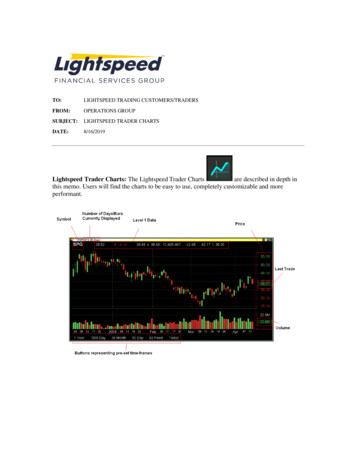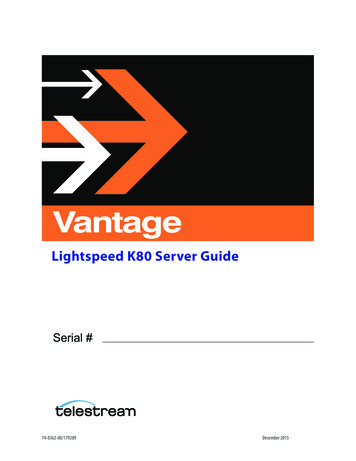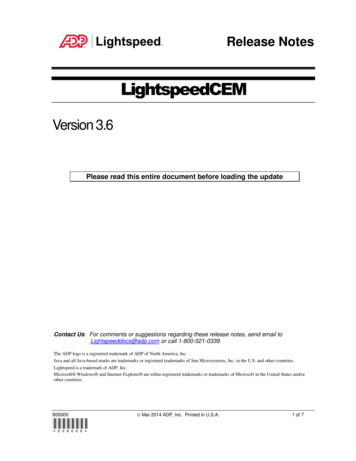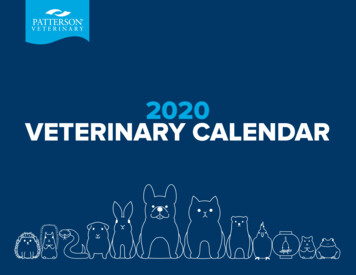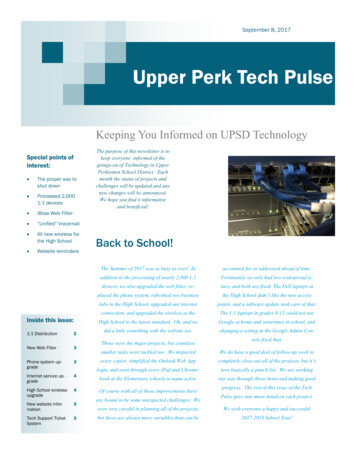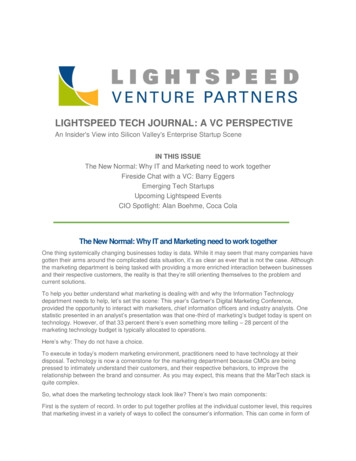
Transcription
LIGHTSPEED TECH JOURNAL: A VC PERSPECTIVEAn Insider's View into Silicon Valley's Enterprise Startup SceneIN THIS ISSUEThe New Normal: Why IT and Marketing need to work togetherFireside Chat with a VC: Barry EggersEmerging Tech StartupsUpcoming Lightspeed EventsCIO Spotlight: Alan Boehme, Coca ColaThe New Normal: Why IT and Marketing need to work togetherOne thing systemically changing businesses today is data. While it may seem that many companies havegotten their arms around the complicated data situation, it’s as clear as ever that is not the case. Althoughthe marketing department is being tasked with providing a more enriched interaction between businessesand their respective customers, the reality is that they’re still orienting themselves to the problem andcurrent solutions.To help you better understand what marketing is dealing with and why the Information Technologydepartment needs to help, let’s set the scene: This year’s Gartner’s Digital Marketing Conference,provided the opportunity to interact with marketers, chief information officers and industry analysts. Onestatistic presented in an analyst’s presentation was that one-third of marketing’s budget today is spent ontechnology. However, of that 33 percent there’s even something more telling – 28 percent of themarketing technology budget is typically allocated to operations.Here’s why: They do not have a choice.To execute in today’s modern marketing environment, practitioners need to have technology at theirdisposal. Technology is now a cornerstone for the marketing department because CMOs are beingpressed to intimately understand their customers, and their respective behaviors, to improve therelationship between the brand and consumer. As you may expect, this means that the MarTech stack isquite complex.So, what does the marketing technology stack look like? There’s two main components:First is the system of record. In order to put together profiles at the individual customer level, this requiresthat marketing invest in a variety of ways to collect the consumer’s information. This can come in form of
customer relationship management (CRM) systems, data management platforms (DMP) and othervarious marketing automation tools, such as Percolate.According to the latest Gartner research, the top use cases that businesses are trying to solve relate backto the customer — this includes marketing, sales and customer service initiatives.The second major component is a bit more complex. That’s because in order to take this customerinformation and put it to use, today’s marketer needs a slew of point solutions to execute on marketing’sefforts. Because marketers are constantly chasing the best-in-breed product that means the stackcontinues to grow to fit departmental needs. It’s not uncommon to have an enterprise-grade marketingorganization leveraging more than 20 systems to carry out their daily tasks.Below is an example of a marketing technology stack that participated in Scott Brinker’s annual StackiesAwards.There’s just one problem. If marketers have upwards of 20 source systems, putting together thisinformation can be difficult — of course this is assuming that the team knows which information it wants tobring together, and can decipher what is simply noise and what is of the utmost importance. While piecesof the stack can be connected natively that does not mean they’re connected for data analysis.This means that in order to get the most out of this information it requires combining these various datapoints. That way, marketers can understand how they’re performing with customers on a micro level. Ifonly it was that easy and today’s latest tools could bring together this data.This is why many of today’s marketers rely on impractical solutions such as cramming as much data into
Microsoft Excel spreadsheets as possible. You can only imagine the pain and suffering of manuallygathering data points into complex Excel documents. Companies like Datorama are solving this problemfor marketers and CIOs. And this is why now, more than ever, today’s marketers and IT need to worktogether.Fireside Chat with a VC: Barry EggersBarry is a Founding Partner of Lightspeed and focusesprimarily on information technology infrastructure, with aspecific interest in big data, cloud, IoT, networking, andstorage. He has 18 years of venture capital experience, 10years of operating experience and has been named to theForbes Midas List of top 100 investors multiple times.How did you get into venture investing?Chris Schaepe was my classmate at the Stanford Business School. After graduation, he went into venturecapital and I went to Cisco System. In 1995, I developed Cisco’s M&A program and lead three of their firstfour acquisitions, one of which was a company called Kalpana that Chris was an investor in. Wereconnected, and Chris felt that the M&A background would be compelling in a venture capital role. Heeventually recruited me to join Weiss Peck and Greer Venture Partners in January 1997.In your opinion, what category of technology will be the most impactful to businesses in the next 3-5 years?I’m excited about the potential for data analytics, combined with machine learning, to disrupt large stapleindustries. Examples include autonomous vehicles, banking, and bioinformatics.What is the most exciting enterprise technology startup in Silicon Valley right now?The most exciting enterprise technology startup is the one that is being formed right now in a garage byvisionary entrepreneurs.Which of your past investments are you most proud of?I’ve had a number of investments with high return multiples, such as Sirocco Systems, MakerCommunications, Calista, Growth Networks, Telogy, and Nimble Storage, so it may surprise you that theinvestment I’m most proud of, Pliant Technology, only delivered a 4-5X return. The reason I’m proud of itwas because Pliant was the very first venture investment in the valuable area of enterprise flashstorage. Our early investment in Pliant informed us of the enormous opportunity in Flash storage wellahead of our peers, enabling Lightspeed to place additional early bets in a series of successful platformcompanies including FusionIO, Nimble Storage, Nutanix, Tintri, and ExtremeIO.If you were not an investor, what would you be doing right now?I have a short attention span, so as an investor, I prefer fast-paced decisions, a variety of interestingwork, and context switching. If I wasn’t an investor, I think I’d want to be a movie producer, a GM of afootball team, or a comedy writer.
Datorama's SaaS platformcombines data managementand machine-learning to givemarketers the ability to connectall of their data sources to forma single source of truth for moreefficient reporting, betterdecision-making and totalcontrol over their marketingperformanceEverstring helps B2Bcompanies identify their bestcustomer prospects throughdata science and predictiveanalytics. EverStringintelligently scores inbound andexisting prospects, and alsoidentifies completely newprospects from outside yourfunnelReflektive is a performancemanagement and real-timefeedback platform. It allowsemployees to give each othercontinuous feedback, and thenaggregates this feedback into asimple and intuitive performancereview. The continuousfeedback is collected from withinthe apps employees already usesuch as email, Slack, SalesforceUPCOMING LIGHTSPEED EVENTSSilicon Valley Venture Connect NYC: We will be hosting our 2nd annual Lightspeed-exclusiveconference at Four Seasons in Manhattan on November 10th, 2016 from 6-9pm. You can see moredetails and register here: com/#rsvpLightspeed CIO Spotlight: Alan BoehmeAlan Boehme is the CTO & CIO at Coca-Cola. Alanispart of Lightspeed’s CIO Innovation Advisory Network.To join the network, please email Saqib atsaqib@lsvp.comWhat is your philosophy as a CIO?The role of the CIO is to provide Business Vision, clear hurdles out of the way for the IT team and protectand enhance the corporate culture by applying digital solutions and technology in a manner appropriatefor the enterprise.How does the IT planning process work at Coca-Cola? How closely tied is it to the businessplanning process?The IT planning process is tied both in needs as well as timing to that of integrated business plans. Weuse standard methodologies such as ZBW to develop budgets required to support the desired businessdirection.
What is keeping you awake at night?Legacy applications that are not well-positioned to move to the cloud.What are your top three initiatives for the next year?New HR eco-system based on WorkDay, Improving the Employee Experience, and Leveraging cloudbased analytic and machine learning capabilities.What are some of the exciting emerging technologies that you think will be applicable to CIOs andtheir organizations?Industrial Focused Augmented Reality technology, Video Analytics capabilities, Social Physics forunderstanding consumer behavior.How would you describe the future role of the CIO?Part Business Visionary, Part VC, Part Operator, but most importantly “Digital Change Agent."What advice do you have for new or aspiring CIOs?Make sure that you have a solid business understanding, the technology is portable across multipleindustries but the application of the technology requires in depth business knowledge.
Communications, Calista, Growth Networks, Telogy, and Nimble Storage, so it may surprise you that the investment I'm most proud of, Pliant Technology, only delivered a 4-5X return. The reason I'm proud of it was because Pliant was the very first venture investment in the valuable area of enterprise flash storage.
